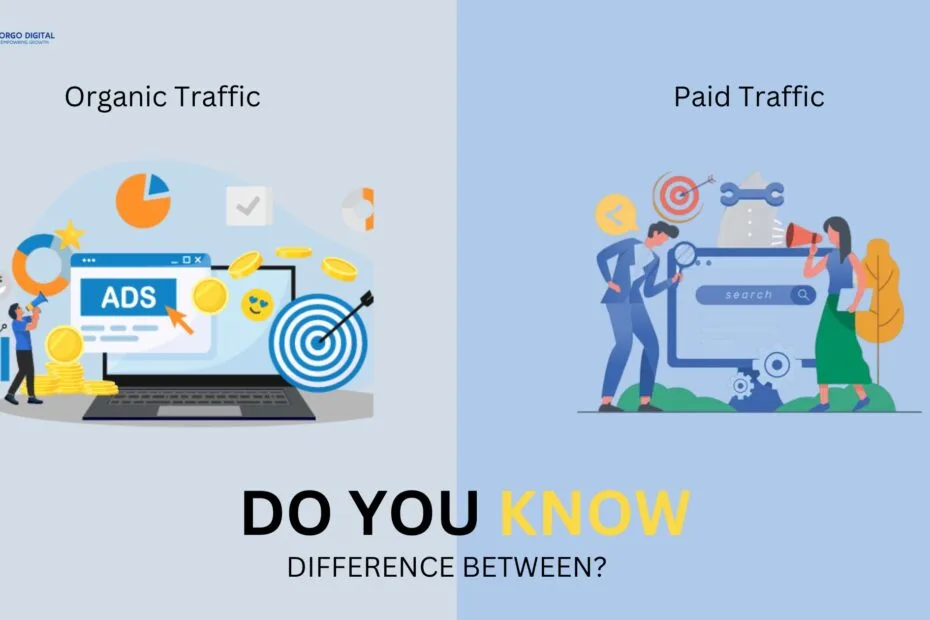In the digital age, driving traffic to your website is a crucial component of any successful marketing strategy. Website traffic is the lifeblood of online businesses, whether you aim to build brand awareness, generate leads, or make sales. Two primary approaches to achieving this are organic traffic and paid traffic. While both methods serve the same purpose—bringing visitors to your site—they differ significantly in approach, cost, and impact. In this blog, we will explore the differences between organic traffic and paid traffic, helping you determine which strategy aligns best with your business goals.
What is Organic Traffic?
Organic traffic refers to visitors who land on your website through unpaid channels. These include search engine results, social media shares, email links, or direct visits. Unlike paid campaigns, organic traffic grows naturally over time through strategic efforts like search engine optimization (SEO), content marketing, and backlinks.
Characteristics of Organic Traffic:
- Free but requires investment in time and effort.
- Sustainable over the long term.
- Builds brand authority and trust among users.
- Dependent on quality content and SEO practices.
Sources of Organic Traffic:
- Search engine results (Google, Bing, etc.).
- Social media platforms through organic posts and shares.
- Referral traffic from other websites linking to yours.
- Direct visits from loyal customers or readers.
Key Tools for Tracking Organic Traffic:
- Google Analytics: Tracks user behavior and sources.
- Google Search Console: Monitors keyword rankings and site performance.
What is Paid Traffic?
Paid traffic is the result of advertising campaigns on platforms like Google Ads, Facebook Ads, or Instagram Ads. Businesses pay to display their website links on these platforms, targeting specific audiences based on demographics, location, interests, and behavior.
Characteristics of Paid Traffic:
- Requires financial investment for every click or impression.
- Delivers immediate results.
- Offers precise targeting and control.
- Stops when you halt payments.
Popular Paid Traffic Platforms:
- Search engine advertising (Google Ads, Bing Ads).
- Social media advertising (Facebook, Instagram, LinkedIn, Twitter).
- Display and retargeting ads.
Key Tools for Tracking Paid Traffic:
- Google Ads Manager: Monitors ad performance and ROI.
- Facebook Ads Manager: Tracks campaign metrics and audience insights.
Key Differences Between Organic and Paid Traffic
| Aspect | Organic Traffic | Paid Traffic |
|---|---|---|
| Cost | Free but time-intensive. | Requires a budget for ad campaigns. |
| Timeframe | Gradual results over weeks or months. | Instant results as soon as ads are live. |
| Sustainability | Long-lasting and consistent. | Temporary; stops when payments cease. |
| Credibility | Builds trust through natural visibility. | Seen as promotional; may lack authenticity. |
| Control | Limited control over results. | Full control over targeting and budget. |
| Targeting | Reaches a broad audience. | Allows specific targeting based on preferences. |
| Effort Required | High initial effort; lower ongoing maintenance. | Moderate effort; continuous ad management needed. |
| Scalability | Slower to scale. | Easy to scale by increasing ad spend. |
Pros and Cons of Organic Traffic
Pros:
- Cost-effective in the long run.
- Builds credibility and trust.
- Delivers consistent traffic over time.
Cons:
- Requires significant time and effort.
- Results are influenced by search engine algorithms.
Pros and Cons of Paid Traffic
Pros:
- Provides instant visibility and traffic.
- Highly measurable and data-driven.
- Offers precise audience targeting.
Cons:
- Can become expensive without proper management.
- Traffic stops immediately when ad spend stops.
When to Use Organic Traffic vs Paid Traffic
Organic Traffic is Ideal for:
- Long-term strategies.
- Building a loyal audience and brand credibility.
- Budget-conscious businesses.
Paid Traffic is Ideal for:
- Launching new products or services.
- Short-term campaigns and promotions.
- Highly competitive industries.
Combining Organic and Paid Traffic Strategies
A well-rounded approach involves combining both organic and paid traffic strategies to maximize results. Use paid campaigns to kickstart traffic while building organic momentum. Over time, your organic efforts can reduce reliance on paid campaigns, creating a sustainable and cost-effective growth strategy.
How OrgoDigital Can Help
At OrgoDigital, we specialize in crafting tailored digital marketing strategies that combine the best of organic and paid traffic generation. From implementing SEO best practices to managing high-performance ad campaigns, our team ensures your website reaches its full potential.
Our Services Include:
- SEO Optimization and Content Marketing.
- Google Ads and Social Media Advertising.
- Comprehensive analytics and reporting for informed decision-making.
Let us help you drive traffic and achieve your business goals.
Both organic and paid traffic play pivotal roles in digital marketing. While organic traffic offers long-term benefits, paid traffic provides quick results. The key is to balance these strategies to suit your business objectives and budget. Ready to take your website traffic to the next level? Contact OrgoDigital today and let us empower your growth!

